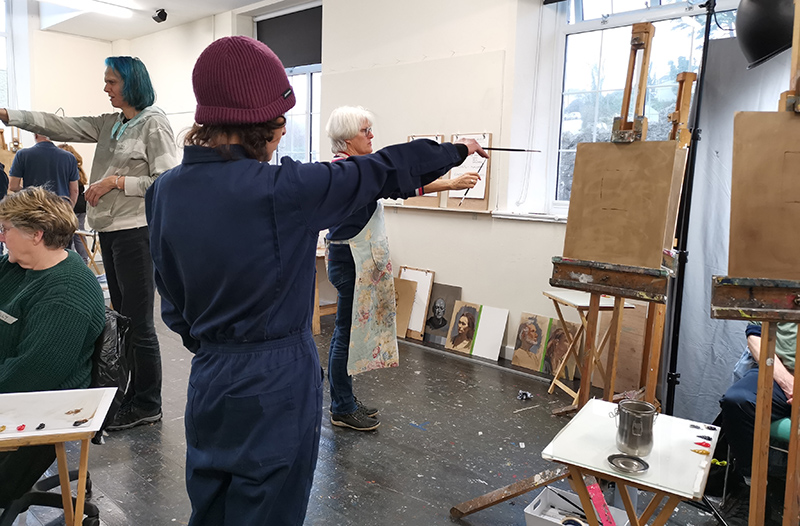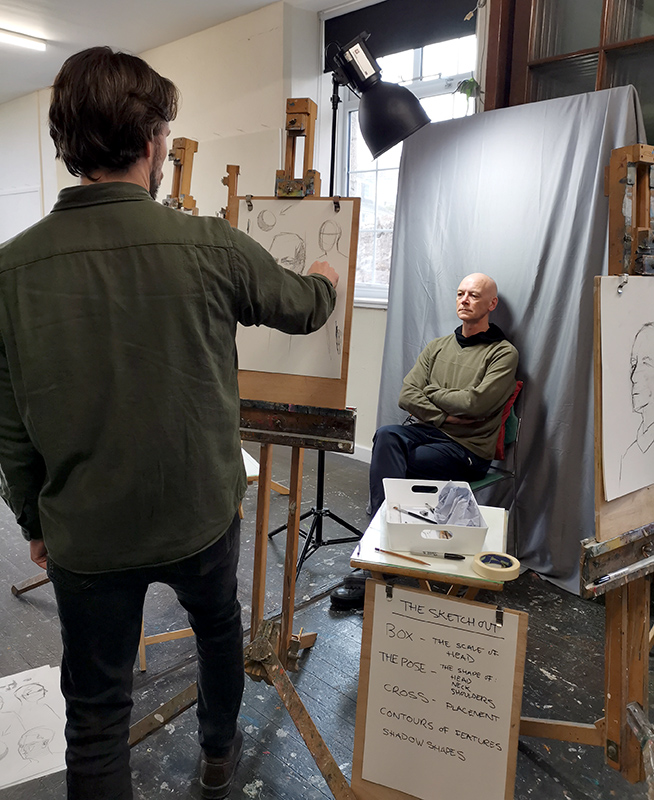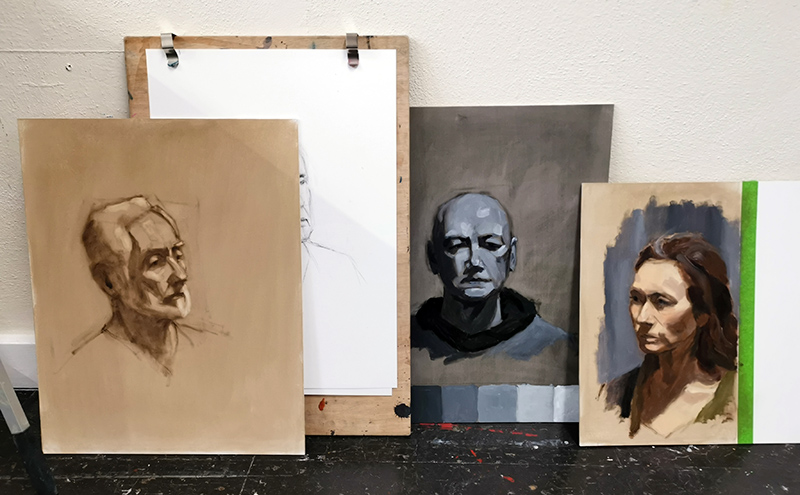The Portrait
4-day course with Jon Doran
‘Creating portraits can feel challenging at times and yet, when you get it right – when you capture the character and essence of a person in paint – it can be tremendously rewarding,’ our tutor, Jon Doran, enthuses as we gather for the first session of The Portrait course.
‘This, however, is not the day we make the perfect painting,’ he adds, smiling.
‘My goal here is to build upon your understanding of how a successful portrait works. If all goes to plan, by the end of our time together you’ll have a good range of techniques and processes to take away with you, and perhaps even a painting you’re happy with too.’
Some of us – I raise my hands here – are a little nervous. After all, it is one thing painting a landscape or a still-life, but neither of those would be offended if you painted them badly. Here, we have living, feeling models patiently awaiting our scrutiny. This does add an extra layer of trepidation to the experience.

Jon quickly puts at ease. To avoid us becoming overwhelmed even before we pick up a paintbrush, he has devised a tried-and-tested approach which makes the process of painting more manageable. During these four days together we will be exploring, in depth, four key areas of creating a portrait in oils: drawing, tone, colour and application. By tackling these ideas one at a time, Jon intends that by the end of the course, we will no longer be randomly trying to achieve a likeness, but will have a practiced understanding of the fundamental mechanics of portrait painting. I cannot wait.
We assemble at three stations – a model at each – with easels carefully-arranged so that each of us has a perfect view. Today, our focus is drawing a loose yet measured foundation for a painting.
We begin by painting in thinned oil paint a simple box representing the head, before working out the correct angles of the neck and shoulders. ‘It’s like creating a sculpture,’ Jon advises. ‘You start with a big block and then start shaping. The details come last. This is all about how different parts of the face and body fit together. The likeness of a person is in the big shapes and how they relate to each other. If we establish these relationships correctly first, then everything else should fall into place.’
This is easier said than done. I’m not familiar with drawing in oil paint so it takes a while for me to get the hang of things, but I gradually relax and find my flow. I can sense that the others in our group are feeling much the same way.

There are twelve of us on this course, and we are an enthusiastic bunch. Around half have an existing creative practice and want to improve their technique, the rest are less confident and want more structured guidance. No matter what our experience, Jon is on hand, providing generous appreciation of our efforts and offering constructive advice on how to build on what we’ve already created.
Jon’s own work is inspired by the Realist tradition, and we too are following the principles of this style of painting. As Jon explains it, we will be painting as the eye sees: ‘We’re not articulating every hair or every pore of the skin, as a camera would,’ he explains. ‘We are describing how we experience the person in front of us. A portrait is a very special thing. It encapsulates everything that makes us human; it is our response to encountering another person. The way we paint is an effort to describe something about them, whether it is a sense of their personality or an accurate representation of how they look.’
The following day we focus on assessing and creating correct tonal values. We note where the light source is coming from, and look keenly at how the shadows fall. Squinting helps to reduce the ‘visual noise’ so that we can begin to see the face as an abstract assemblage of shapes of light and dark. This tonal range, according to Jon, is the language of the 3D world, and the most important aspect if you want your painting to look real.

At the start of each new step, Jon takes us through a demonstration, proving with each brushstroke why he is the perfect tutor for this course. With enviable ease, in just a few deft marks and blocked out shapes, he is able to immediately capture the likeness of each of the models. Accuracy comes with practice, he tells us, and with learning how to see correctly. We need to disregard how we think something looks, and record instead the exact forms and shapes in front of us.
Naturally, there are times when each of us becomes disheartened or downright lost as we try to rescue a failing painting. Jon remains unflappable, reminding us that each step is an essential building block in itself. Trying to rush ahead, he advises, is likely to cost us time and frustration in the long run. ‘The good news,’ he smiles, ‘is that you are not alone, and there is an answer to everything.’
The remaining days are filled by working with colour, then application. Each day involves fresh boards, a different model or position, and repeating the now-familiar framework. When we break between poses there’s chatter and bonhomie as we admire each other’s work. It is fascinating how each painting can describe a different aspect of the same person.

Too quickly, we’re packing up and saying our goodbyes. I have enjoyed the last four days immensely. I know, too, that all of us will be taking this practical system of enquiry and application into our own creative practices.
‘It is liberating when you understand the mechanics of painting,’ Jon says in his sum-up. ‘There’s a moment where it all clicks into place, and then it is very exciting, because then you can take risks and still produce something that captures the vivid likeness of a person.’
That, I imagine, takes considerable practice. I may not be there yet, but I have rediscovered a love of portraiture. There’s something quite profound in trying to capture in paint not just an accurate representation of form, but the elusive sense of a personality; the spark of life in another human being.
And so my journey continues.
- Kari Herbert
Find out more about The Portrait with Jon Doran here.